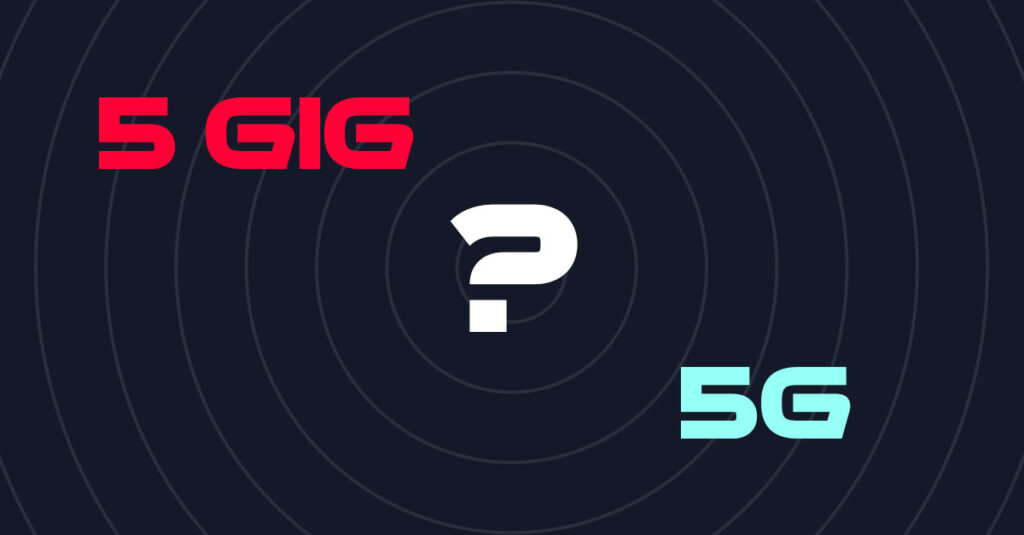
What is the Difference Between 5 Gig and 5G?
6 commentsIf you’re shopping for new mobile phone or home internet service, you’ll come across a whole alphabet soup of acronyms to decode. It’s confusing, so let’s get smart about what 5 Gig, 5G and even 5GB and 5GHz all mean.
Why so many G’s?
Gig is all about gigabit, which is a measure of internet speed. Gig is an ultrafast internet speed for your home network that is delivered through a fiber optic connection. Gig is short for “Gbps,” or gigabits per second. Gigabit shows how much data can move over a connection at a time. More on that later, but 5 Gig is a lot!
When you see 5G, the G means the generation of mobile network technology. 5G (5th Generation) is the most current generation. It’s a new standard that takes advantage of a wide spectrum of radio waves, plus the latest advancements in mobile networking hardware, to provide improvements in speed and reliability. The average 5G mobile and home speeds are under 200 Mbps—far lower than gig speeds available on your home network with fiber internet service.
Gigabytes are a unit of data size. This tells you how large a file is and how much data a device can store. Every file you send or receive uses a quantity of data, which is measured in bytes. One gigabyte is equal to 1 billion bytes of data. You need to watch your storage on your devices like computer hard drives, cell phones, tablets and gaming consoles to make sure you have the room you need for files.
Gigahertz is a number you might see on your home dual-band router. It means 5 Gigahertz which indicates one of the frequencies for delivering internet service to all of the devices in your home. Wi-Fi currently comes in three frequencies: 2.4 GHz, 5 GHz and 6 GHz. 2.4 GHz is the default for most devices, which results in declined speeds but more availability throughout the house or office. It is utilized by Bluetooth, remote controls, and microwave ovens. It can get crowded quickly, resulting in decreased speeds.
The 5GHz setting offers faster speeds than 2.4 GHz and can penetrate through network clutter disturbances and interferences to maximize network performance. Despite this, its range is shorter than that of 2.4 GHz, and it often struggles to travel through solid objects such as walls. 5GHz Wi-Fi doesn’t broadcast 5G cellular signals and cannot connect to them either. It has nothing to do with the mobile network standard of 5G.
It gets confusing when 5 Gig, 5GB and 5 GHz are all called gig! But now that you know what they all are, what do 5G and 5 Gig mean for you?
5G is for cellular networks
The 5G generation of technology is mostly used for mobile devices, both in and out of your home. However, given the broader capacity of 5G, some wireless providers are offering 5G home internet based on the same tech. It uses existing cell towers, plus a 5G router, to provide broadband service to your home. Note that while 5G is the fastest mobile internet yet, it doesn’t denote a particular speed. It just means it’s using the latest standard in cellular networking.
5 Gig is very fast fiber
A speed of 5 Gig—5 gigabits per second—is one of the fastest speeds you can get in your home. With 5 Gig fiber, you’ll have an ultrafast broadband connection with symmetrical speeds for both downloads and uploads, so your uploads are just as fast as your downloads. According to Speedtest.net the median 5G connection in the U.S. in October 2023 had a download speed around 215 Mbps and an upload speed around 24 Mbps. So your 5 Gig speed can be 23 times faster. If you’re a gamer, the benefits are huge.
The future of 5G and 5 Gig and you
Looking ahead, 5G technologies will also serve a great many devices in near real time. Outside your home network, it will be important for our growing use of internet-connected cars, environmental sensors, thermostats and other gadgets. For instance, 5G is expected to help autonomous cars communicate not only with one another, but also, someday, with roads, lights, parking meters and signals. Even though 5G remains far from universally available, the telecom industry is already looking forward to the next big thing: 6G. This technology will take advantage of areas of the wireless spectrum above 100 GHz.
History points the way for the future of fiber internet, too: Would you need another Wi-Fi router for 5 Gig? Improved hardware, better security and networking protocols already mean it makes sense to replace your router every few years. But if you are switching to a 5 Gig connection, you’ll likely need a new router to take full advantage of it. Your connection will likely still work, but you won’t have access to the bandwidth you otherwise would.
But what does this mean for you practically, right now? And why would you want these ultrafast speeds?
Benefits of high fiber speeds and bandwidth
Higher bandwidth can be great for larger households with a lot of demand. Think lots of connected devices, smart home tech, simultaneous streaming and so on. But even if you don’t live in a large household, the world changes fast enough for you to realize the benefits connections like fiber can offer.
Every few years, new technology comes along hungry for more bandwidth. Around 20 years ago, social networking produced volumes of photographs that required greater bandwidth to enjoy. A decade ago, streaming video asked web users for more bandwidth than that. And in the last few years, the prevalence of higher-resolution streaming like 4K has sucked up even more.
What’s next? Over the past few years, consumer technology companies have swung for the fences with new virtual reality, or VR, products, and in summer 2023, Apple announced its own foray into the space with the Apple Vision Pro. As VR tech matures and enters the mainstream, high-bandwidth internet offers higher-fidelity spatial video calling, faster downloads of bandwidth-intensive VR products, more robust streams of VR content and lag-free VR gaming.
So, do you need both 5G and 5 Gig internet?
It’s great to have both 5G and 5 Gig together, especially when you’re using your 5G mobile phone outside of Wi-Fi coverage. And fiber comes with huge upsides, too, in stability, in symmetrical upload and download speeds, and speed itself.
Frontier Fiber is built for the way you live today—and tomorrow
If you’re still on the lookout for the right ultrafast internet connection for streaming, gaming, working from home and running your smart home—all with enough bandwidth for everyone—find out about Frontier Fiber. Frontier Fiber is available in select areas—check here to see when it’s available at your address. And learn more about Frontier Fiber 5 Gig Internet.
Product features may have changed and are subject to change.




i’d like to try it for a week or so to see if my pc can handle it or not
Hi Philip, we’re always excited about interest in our Fiber. We don’t have a trial option but it should be easy enough to assess if your computer is ready for multi-gigabit Internet service. The main thing you would need to take advantage of the full bandwidth of 5Gbps is a 5GBase-T or 10GBase-T Ethernet interface on your computer. If your computer has a 2.5Gbase-T or the much more ubiquitous 1000Base-T, you would be limited to those speeds on the computer. If your hardware is good to go you can check availability here: https://fybr.to/3T9XUzy ^Michael
When is Frontier Fiber 5 Gig be available at my address?
Hi Gilberto, we’re always excited to share news of our Fiber expansion and industry leading multi-Gigabit symmetrical speeds! You can check here for availability, sign up for notifications, and nominate your area https://fybr.to/3uBgmaT ^Michael
When are we getting fiber in our area?
It’s a ready a mile from us.
HI Edward, you can check for availability here https://fybr.to/49rjDIN and if it’s not showing the site will provide the option to nominate your area. If you get that option be sure to share the site with your neighbors! ^Michael